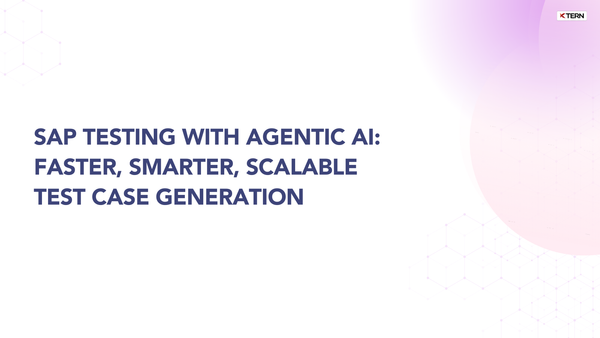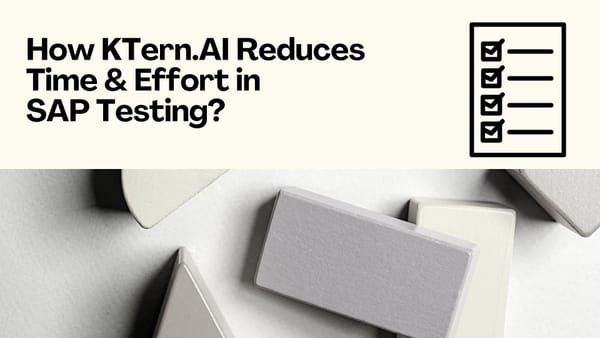Optimizing SAP Testing with Risk-Based Testing (RBT) and KTern.AI
Introduction:
As organizations adopt digital technologies and undergo digital transformation, the importance of testing increases. Testing is a crucial part of software development, ensuring both the quality and stability of the applications developed.
In today’s fast-paced digital ecosystem, developers must stay updated with new trends and continuously enhance their applications. As a result, we are witnessing more frequent releases and updates in the applications we use.
For enterprises using SAP, the complexity of processes and systems grows over time, leading to an increase in the number of transports released. This, in turn, raises the effort and time required for testing. The time needed to test all the test cases has grown, putting organizations under pressure due to frequent delays and disruptions in releases. To tackle this, the concept of Risk-Based Testing (RBT) evolved.
Risk-Based Testing (RBT):
Risk-Based Testing (RBT) in SAP is a testing strategy that prioritizes testing efforts based on the risk of disruption in different areas within the SAP system. The goal of RBT is to focus resources on the most critical areas that, if not functioning properly, would have the highest impact on business operations.
Key Concepts of Risk-Based Testing in SAP:
- Risk Identification: Identify potential risks in the SAP system, such as changes in high-impact modules (e.g., Finance, Supply Chain) or critical business processes. Risks can also arise from new developments, updates, or transports.
- Risk Assessment: Evaluate the identified risks based on their likelihood and potential impact on the business. This assessment helps in determining the priority of test cases.
- Test Case Prioritization: Based on the risk assessment, prioritize test cases that address the most critical and high-risk areas. This ensures that the most important functionalities are thoroughly tested first.
- Resource Optimization: Allocate testing resources efficiently by focusing on high-risk areas. This allows for faster and more targeted testing, reducing the time and cost involved.
- Continuous Risk Evaluation: As the SAP environment evolves with new updates or configurations, continuously reassess risks and adjust testing priorities accordingly.
How Risk-Based Testing works?
Risk-Based Testing (RBT) in SAP involves a structured approach to prioritize testing efforts based on risk. Below are the typical process steps involved in implementing Risk-Based Testing in an SAP environment:
1. Identify Key Business Processes and Components
Understand Business Impact: Begin by identifying the key business processes and SAP components that are critical to the organization's operations.
Mapping Dependencies: Map out the dependencies between SAP modules, transactions, and customizations to understand which areas are most susceptible to failure.
2. Risk Identification
Change Impact Analysis: Assess changes or updates, such as new transports, custom developments, or system upgrades, to identify potential risks.
Document Potential Risks: List risks associated with each component, such as system downtimes, financial discrepancies, or compliance violations.
3. Risk Assessment and Prioritization
Risk Evaluation: Evaluate the identified risks based on two criteria: the likelihood of failure and the impact on business operations.
Assign Risk Scores: Assign risk scores to each process or component based on the evaluation. High-risk areas are those with both high impact and high likelihood of failure.
Prioritize Test Cases: Prioritize the test cases based on risk scores, focusing on high-risk areas first.
4. Test Planning
Develop a Test Strategy: Create a test plan that aligns with the prioritized risks. This plan should outline the test scope, objectives, timelines, and resource allocation.
Select Test Types: Choose appropriate test types (e.g., regression testing, performance testing, integration testing) based on the risk and criticality of the areas being tested.
5. Test Execution
Run High-Priority Tests First: Execute test cases starting with the highest risk areas to ensure that critical functionalities are thoroughly validated.
Monitor and Track Issues: Continuously monitor the test execution process, track defects, and resolve any critical issues identified during testing.
6. Risk Mitigation and Reassessment
Risk Mitigation Actions: Implement risk mitigation strategies such as bug fixes, additional testing, or system adjustments to address any identified risks.
Reassess Risks: After each testing cycle, reassess risks to adjust the testing focus as needed. This step ensures that any new risks arising from changes are promptly addressed.
7. Reporting and Documentation
Document Test Results: Record the outcomes of the testing process, including pass/fail status, defect details, and areas covered.
Communicate Findings: Share risk assessment results, test coverage, and any residual risks with stakeholders to inform decision-making.
8. Continuous Improvement
Review and Optimize: After each release or project, review the effectiveness of the RBT approach and optimize the process for future cycles. Incorporate lessons learned and update the risk assessment process accordingly.
Benefits of Risk Based Testing:
Risk-Based Testing (RBT) in SAP offers several benefits, especially in complex environments where testing every aspect of the system may not be feasible. Here are the key benefits:
1. Efficient Use of Resources
Focused Testing: RBT focuses on testing the most critical and high-risk areas first, allowing teams to allocate their resources more effectively.
Cost Savings: By prioritizing high-impact areas, RBT reduces the time and effort spent on low-risk components, leading to cost savings in testing.
2. Improved Quality and Reliability
Reduced Risk of Failures: By concentrating on areas with the highest risk, RBT minimizes the likelihood of critical failures in the SAP system, ensuring that essential business processes remain stable.
Proactive Risk Management: RBT identifies potential issues early in the development cycle, allowing for timely mitigation and reducing the chances of defects reaching production.
3. Faster Time-to-Market
Accelerated Releases: Since testing is focused on the most critical areas, teams can complete testing more quickly, leading to faster release cycles and reduced time-to-market.
Fewer Delays: RBT helps avoid delays in project timelines by preventing bottlenecks caused by unnecessary testing of low-risk components.
4. Enhanced Decision-Making
Informed Decisions: With a clear understanding of where risks lie, stakeholders can make better-informed decisions about where to focus their testing efforts and how to allocate resources.
Prioritized Risk Mitigation: RBT enables teams to prioritize and address the most significant risks, ensuring that high-impact areas receive the attention they need.
5. Improved Stakeholder Confidence
Transparent Risk Management: RBT provides a structured approach to testing that can be easily communicated to stakeholders, increasing their confidence in the testing process and the overall quality of the SAP system.
Alignment with Business Goals: By focusing on critical business processes, RBT ensures that testing efforts are aligned with the organization's priorities, further boosting stakeholder trust.
6. Adaptability and Flexibility
Dynamic Testing Strategy: RBT allows for continuous risk reassessment, enabling the testing strategy to adapt to changes in the SAP environment, such as new updates, configurations, or business requirements.
Scalability: As the complexity of the SAP system grows, RBT scales effectively by adjusting the focus based on changing risk profiles.
7. Reduced Operational Disruptions
Minimized Downtime: By identifying and mitigating high-risk areas, RBT helps prevent disruptions in critical business operations, leading to smoother and more reliable SAP deployments.
Fewer Production Defects: Focused testing on high-risk areas reduces the likelihood of defects making it into production, thereby lowering the chances of costly post-release issues.
8. Compliance and Risk Management
Regulatory Compliance: RBT ensures that high-risk areas related to compliance and governance are thoroughly tested, reducing the risk of non-compliance.
Risk-Aware Culture: RBT promotes a culture of risk awareness within the testing team, encouraging proactive identification and mitigation of potential issues.
How to adopt Risk Based Testing in your SAP ecosystem?
KTern.AI, a digital transformation platform, enhances the RBT process by providing autonomous enterprise release impact, risk assessment, test orchestration and reporting. Here's how KTern.AI can help you adopt and optimize RBT in your SAP ecosystem:
1. Autonomous Enterprise Release Impact (AERI):
KTern.AI offers Autonomous Enterprise Release Impact analysis, which is integral to the RBT process. When new transports, updates, or custom developments are introduced, KTern.AI analyzes the potential impact on your SAP environment, identifying high-risk areas that require focused testing. This automated analysis accelerates risk identification and reduces the manual effort involved in mapping dependencies.
2. Test impact simulation:
The Test Impact Simulation Bot automatically detects changes in the SAP environment, such as new transports, code modifications, or system upgrades. It examines how the change affects various SAP modules, processes, and configurations, and then maps these impacts to the existing test cases in your test repository. By identifying which test cases are directly or indirectly impacted by the change, the bot ensures that your testing efforts are accurately focused on the areas most likely to be affected.
In addition to mapping impacted test cases, the Test Impact Simulation Bot identifies any gaps in test coverage and with Gen AI driven automation it provides the test cases to be created and tested.
The bot not only identifies impacted test cases but also prioritizes them based on the level of risk associated with the changes. Test cases that address high-risk areas or critical business processes are given higher materiality scores. This prioritization allows testing teams to focus on the most important areas first, optimizing resource allocation and reducing the overall time required for testing.

3. Comprehensive Reporting and Continuous Improvement
KTern.AI Digital Mines provides a visual representation of the impacted areas, allowing stakeholders to quickly grasp the scope and severity of the impact. By continuously reassessing and reporting on risks, KTern.AI ensures that the testing strategy remains dynamic and responsive to the changing SAP landscape. The insights provided by the bot empower decision-makers to make informed choices about resource allocation and risk mitigation.


Conclusion:
SAP environments become increasingly complex, Risk-Based Testing (RBT) emerges as a crucial strategy for ensuring that critical business processes remain stable and reliable.
KTern.AI further enhances the RBT process by automating critical aspects such as impact analysis, test case prioritization, and comprehensive reporting. With KTern.AI’s autonomous capabilities, organizations can seamlessly integrate RBT into their SAP ecosystems, ensuring continuous improvement and alignment with business goals.
Adopting RBT with the support of KTern.AI not only minimizes operational disruptions but also fosters a proactive, risk-aware culture within the testing team. As a result, enterprises can confidently navigate their digital transformation journeys, knowing that their SAP systems are robust, compliant, and well-optimized for future challenges.




